Advent and Hanukkah at the Catholic University of Lublin (EN+IT+ES+DE+UA)

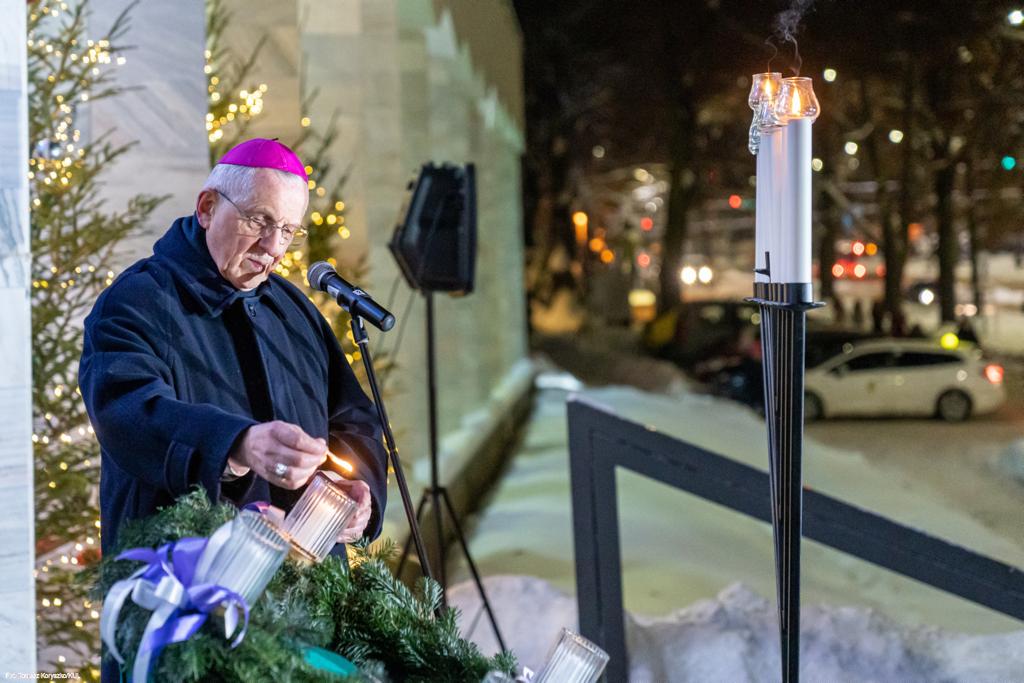
PhotoCredit: KUL_Advent_Hanukkah
The Abraham J. Heschel Center for Catholic-Jewish Relations at the Catholic University of Lublin (KUL) organized a joint celebration of Hanukkah and Advent for the academic community and residents of Lublin, which is a multicultural and multireligious city. “The light of the Hanukkah candlestick and the Advent wreath is an organic unity. It warms and unites,” noted Mieczyslaw Cisło, auxiliary bishop of the Lublin Archdiocese.
*
Il Centro per le Relazioni Cattolico-Ebraiche Abraham J. Heschel dell’Università Cattolica di Lublino ha organizzato una celebrazione congiunta dell’Hanukkah e dell’Avvento per la comunità accademica e gli abitanti di Lublino, una città multiculturale e multireligiosa. La luce del candelabro di Hanukkah e della corona dell’Avvento è un’unità organica. Scalda e unisce – ha osservato Mons. Mieczysław Cisło, Vescovo ausiliare dell’Arcidiocesi di Lublino.
*
El Centro Abraham J. Heschel para las Relaciones Católico-Judías de la Universidad Católica de Lublin (KUL) organizó una celebración conjunta de Janucá y Adviento para la comunidad académica y los residentes de Lublin, una ciudad multicultural y multirreligiosa. “La luz de un candelabro de Janucá y de una corona de Adviento es una unidad orgánica. Calienta y une”, dijo Mieczysław Cisło, obispo auxiliar de la archidiócesis metropolitana de Lublin.
*
Das Abraham J. Heschel Zentrum für katholisch-jüdische Beziehungen an der Katholischen Universität Lublin organisierte eine gemeinsame Chanukka- und Adventsfeier für die akademische Gemeinschaft und die Einwohner von Lublin, einer multikulturellen und multireligiösen Stadt. „Das Licht des Chanukkaleuchters und des Adventskranzes ist eine organische Einheit. Es wärmt und vereint“, so Mieczysław Cisło, Weihbischof der Erzdiözese Lublin.
*
Центр католицько-юдейських відносин ім. Абргама Й. Гешеля при Люблінському католицькому університеті організував спільне святкування Хануки та Адвенту для академічної спільноти та жителів Любліна – багатокультурного та багаторелігійного міста.
The event Light in the Darkness, organized for the first time at the Catholic University of Lublin (KUL), brought together many people: representatives of the Jewish community, students, and passers-by who attended this symbolic meeting in front of the main building of the John Paul II Catholic University of Lublin. “Light paves the way to human hearts and unites. That is why today we are together, Jews and Catholics. We Catholics are discovering the Judaic roots, and Jews are discovering the brotherhood of the Christian faith. This is the fruit of initiatives taken by the University, such as the creation of the Abraham Heschel Center for Catholic-Jewish Relations of the Catholic University of Lublin,” said Bishop Mieczyslaw Cisło, chairman of the Committee of the Polish Bishops’ Conference for Dialogue with Judaism in the years 2006-2016.
As stressed by Fr. Pawel Rytel-Andrianik Ph.D., deputy director of the KUL Heschel Center, the Hanukkah candlestick is a sign from the Old Testament of the recovery of the Jerusalem Temple, and the Advent wreath symbolizes the coming of Jesus as the Messiah. “Lublin is a multicultural, university city, which, before World War II, was home to Yeshivas Chachmei Lublin, the largest Talmudic university in the world. Today the largest Catholic university in Poland, which is the Catholic University of Lublin (KUL), recalls and reminds us of the historical character of the city,” noted Fr. Dr. Andrianik.
The celebration began with the song Shema Israel, after which two commentaries were delivered. The Jewish one was presented by cantor Symcha Keller, while the Catholic one was given by Prof. Wojciech Kaczmarek, head of the Department of Drama and Theater at the Catholic University of Lublin. The meeting culminated with the joint singing of songs by both neocatechumenal and Jewish cantors. “Light unites us, rituals divide us, but this does not mean that our differences are bad. Human beings carry within themselves the light that radiates from the Hanukkiah and the Advent wreath,” concluded Symcha Keller.
Hanukkah is an annual Jewish holiday lasting eight days, beginning on the 25th day of the month of Kislev (according to the Jewish calendar). It commemorates the rededication of the Jerusalem Temple in 165 BC. With Hanukkah is associated the ritual of lighting lights – candles or olive lamps, placed on a special Hanukkah candlestick – a hanukkiah.
The genesis of Hanukkah is related to the events that took place in the Jerusalem Temple on the 25th day of the month of Kislev 165 or 164 B.C., when the ruler of Syria and Palestine, Antiochus IV of the Hellenistic Seleucid dynasty, decided to make the Jews abandon their customs, traditions and Mosaic faith and adopt Greek customs.
The Abraham J. Heschel Center for Catholic-Jewish Relations at the Catholic University of Lublin is a scientific and educational unit that aims to deepen Catholic-Jewish relations. Its patron is Abraham J. Heschel, a Jewish theologian, philosopher, and poet. The Center was inaugurated in October 2022. Its director is Fr. Prof. Miroslaw Wróbel.

PhotoCredit: KUL_Advent_Hanukkah
*
L’evento “Luci nelle tenebre”, organizzato per la prima volta all’Università Cattolica di Lublino (KUL), ha radunato molte persone: rappresentanti della comunità ebraica, studenti e passanti che si sono recati davanti all’Edificio Principale dell’Università Cattolica Giovanni Paolo II di Lublino per partecipare a questo incontro simbolico. – La luce apre la strada al cuore delle persone e le unisce. Per questo oggi siamo insieme, ebrei e cattolici. Noi cattolici scopriamo le nostre radici giudaiche, e gli ebrei scoprono la fratellanza della fede cristiana. Questo è il frutto di iniziative intraprese dall’Università, come il Centro per le relazioni cattolico-ebraiche Abraham Heschel della KUL – ha affermato mons. Mieczysław Cisło, Presidente del Comitato per il Dialogo con il Giusaismo della Conferenza Episcopale Polacca negli anni 2006-2016.
Come ha sottolineato il Rev. Dr Paweł Rytel-Andrianik, Vicedirettore del Centro Heschel della KUL, il candelabro di Hanukkah è un segno dell’Antico Testamento – la liberazione del Tempio di Gerusalemme, e la corona dell’Avvento simboleggia la venuta di Gesù come Messia. – Lublino è una città universitaria multiculturale, dove prima della seconda guerra mondiale operava Jeszywas Chachmej Lublin, la più grande scuola talmudica del mondo. Oggi la più grande università cattolica della Polonia, che è la KUL, fa riferimento e richiama il carattere storico della città – ha osservato il Rev. Andrianik.
La celebrazione è iniziata con il canto Shema Israel, seguito da due commenti. Quello ebraico è stato pronunciato dal cantore Symcha Keller, mentre quello cattolico dal prof. Wojciech Kaczmarek, Direttore del Dipartimento di Dramma e Teatro della KUL. L’incontro si è concluso con il canto comune da parte di cantori neocatecumenali ed ebrei. “La luce ci unisce, i riti ci dividono, ma ciò non significa che le nostre differenze siano negative. L’uomo porta in sè la luce che si irradia dall’Hanukkah e dalla corona dell’Avvento” – ha sintetizzato Symcha Keller.
L’Hanukkah è una festa ebraica annuale che dura otto giorni, a partire dal 25 del mese di Kislev (secondo il calendario ebraico). Commemora la ridedicazione del Tempio a Gerusalemme nel 165 a.C. L’Hanukkah è associata al rito dell’accensione delle luci, candele o lampade a olio poste su uno speciale candelabro – l’Hanukkah.
L’origine dell’Hanukkah è legata agli eventi che ebbero luogo nel Tempio di Gerusalemme il 25.mo giorno del mese di Kislev 165 o 164 a.C., quando il sovrano di Siria e Palestina, Antioco IV della dinastia ellenistica dei seleucidi, decise di forzare gli ebrei ad abbandonare le loro usanze, tradizioni e fede mosaica e adottare le usanze greche.
Il Centro per le Relazioni Cattolico-Ebraiche Abraham J. Heschel dell’Università Cattolica di Lublino è un’unità scientifica ed educativa che ha lo scopo di approfondire le relazioni cattolico-ebraiche. Il suo patrono è Abraham J. Heschel, teologo, filosofo e poeta ebreo. Il Centro è stato inaugurato lo scorso ottobre. Il suo Direttore è il Rev. prof. Mirosław Wróbel.
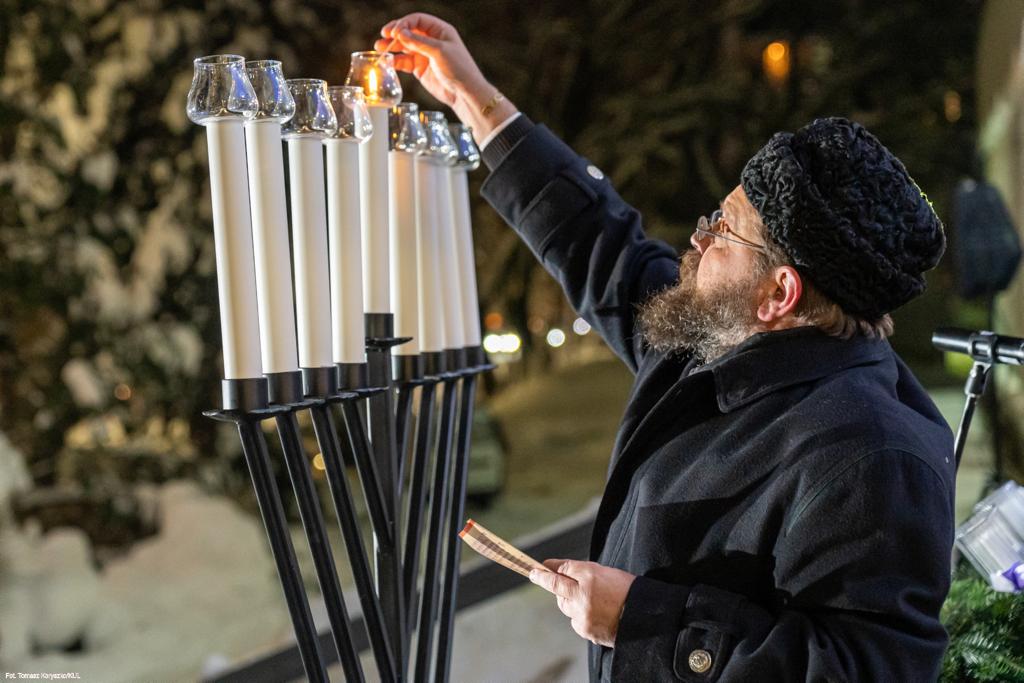
PhotoCredit: KUL_Advent_Hanukkah
*
El acto “la Luz en la Oscuridad”, organizado por primera vez en la Universidad Católica de Lublin (KUL), reunió a numerosas personas: representantes de la comunidad judía, estudiantes y transeúntes que pararon delante del edificio principal de la Universidad Católica Juan Pablo II de Lublin para participar en este encuentro simbólico. “La luz allana el camino a los corazones humanos y une. Por eso hoy estamos juntos, judíos y católicos. Los católicos estamos descubriendo nuestras raíces judaicas y los judíos están descubriendo la fraternidad de la fe cristiana. Este es el fruto de iniciativas tomadas por la universidad, como la creación del Centro Abraham J. Heschel para las Relaciones Católico-Judías de la Universidad Católica de Lublin”, dijo el obispo Mieczysław Cisło, presidente del Comité de la Conferencia Episcopal Polaca para el Diálogo con el Judaísmo de 2006 a 2016.
Como subraya el reverendo Dr. Paweł Rytel-Andrianik, subdirector del Centro Abraham J. Heschel de la Universidad Católica de Lublin, el candelabro de Janucá es un signo del Antiguo Testamento: la recuperación del Templo de Jerusalén, y la corona de Adviento simboliza la venida de Jesús como Mesías. “Lublin es una ciudad multicultural y universitaria donde antes de la Segunda Guerra Mundial funcionaba Yeshivá Jajmei Lublin (en polaco: Jeszywas Chachmej Lublin), la mayor escuela talmúdica del mundo. Hoy, la mayor universidad católica de Polonia, la Universidad Católica de Lublin (KUL), recuerda y remite al carácter histórico de la ciudad”, señaló el padre doctor Andrianik.
La celebración comenzó con el canto del Shema Israel, seguido de lecturas de dos comentarios. El comentario judío fue pronunciado por el cantor Symcha Keller, mientras que el católico por el profesor Wojciech Kaczmarek, director del Departamento de Drama y Teatro de la Universidad Católica de Lublin. La reunión finalizó con un canto conjunto realizado por cantores neocatecumenales y judíos. “La luz nos une, los rituales nos dividen, pero esto no significa que nuestras diferencias sean malas. Los seres humanos son portadores de la luz que irradian la Januquiá y la corona de Adviento”, concluyó Symcha Keller.
Janucá es una festividad judía anual de ocho días de duración, que comienza el día 25 del mes de Kislev (según el calendario judío). Conmemora la rededicación del Templo de Jerusalén en el año 165 a.C. Asociado a Janucá está el ritual de encender las luces, velas o lámparas de olivo, colocadas en un candelabro especial de Janucá: la Januquiá.
Los orígenes de Janucá están vinculados a los acontecimientos que tuvieron lugar en el Templo de Jerusalén el día 25 del mes de Kislev 165 ó 164 a.C., cuando el gobernante de Siria y Palestina, Antíoco IV, de la Dinastía Seléucida, una dinastía hellenistica, decidió obligar a los judíos a abandonar sus costumbres, tradiciones y fe mosaica y adoptar las costumbres griegas.
El Centro Abraham J. Heschel para las Relaciones Católico-Judías de la Universidad Católica de Lublin es una unidad científica y educativa cuyo objetivo es profundizar en las relaciones católico-judías. Su patrón es Abraham J. Heschel, teólogo, filósofo y poeta judío. El Centro se inauguró en octubre de este año. Su director es el reverendo Prof. Miroslaw Wróbel.
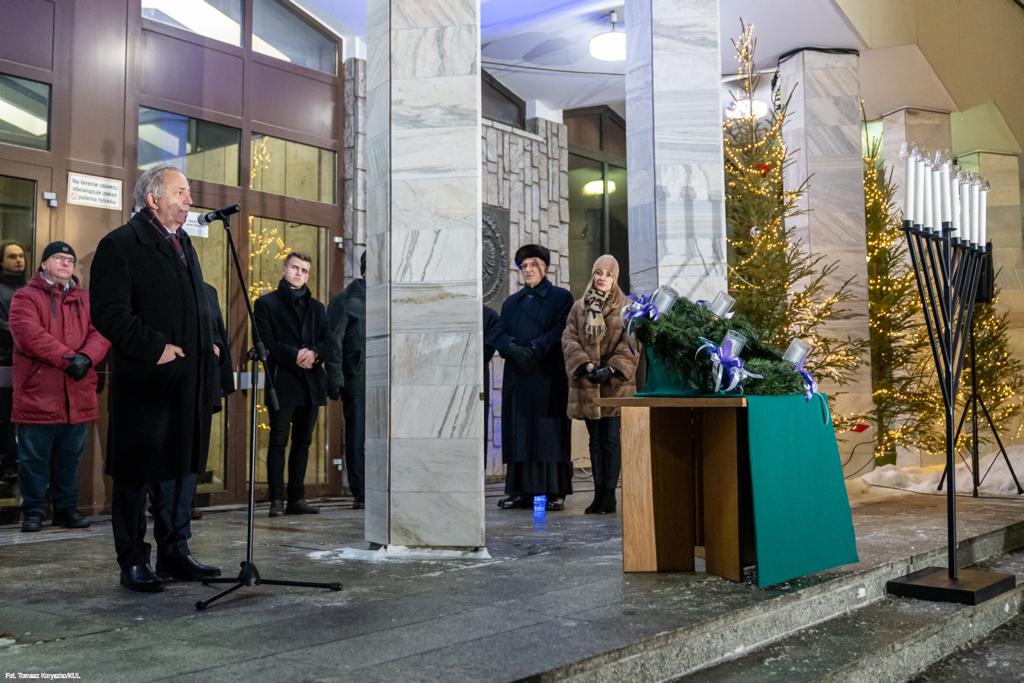
PhotoCredit: KUL_Advent_Hanukkah
*
Die Veranstaltung „Lichter in der Dunkelheit“, die zum ersten Mal an der KUL organisiert wurde, brachte viele Menschen zusammen – Vertreter der jüdischen Gemeinde, Studenten und Passanten, die sich vor dem Hauptgebäude der Katholischen Universität Johannes Paul II. in Lublin versammelten, um an dieser symbolischen Begegnung teilzunehmen. „Das Licht macht den Weg zu den Herzen der Menschen frei und vereint sie. Deshalb sind wir heute zusammen, Juden und Katholiken. Wir Katholiken entdecken die jüdischen Wurzeln und die Juden entdecken die Brüderlichkeit des christlichen Glaubens. Dies ist das Ergebnis von Initiativen der Universität, wie der Gründung des Abraham Heschel Zentrums für katholisch-jüdische Beziehungen an der KUL“, sagte Bischof Mieczysław Cisło, Vorsitzender des Ausschusses der Polnischen Bischofskonferenz für den Dialog mit dem Judentum in den Jahren 2006-2016.
Pfarrer Dr. Paweł Rytel-Andrianik, stellvertretender Direktor des Heschel-Zentrums der Katholischen Universität Lublin, betonte, dass der Chanukkaleuchter ein Zeichen des Alten Testaments sei – der Wiedereinweihung des Jerusalemer Tempels, und der Adventskranz symbolisiere das Kommen Jesu als Messias. „Lublin ist eine multikulturelle Universitätsstadt, in der sich vor dem Zweiten Weltkrieg die Chachmei Lublin Jeschiwa, die größte Talmudschule der Welt, befand. Heute verweist die größte katholische Universität Polens, die Katholische Universität Lublin, auf den historischen Charakter der Stadt und erinnert uns daran“, sagte Pfarrer Dr. Andrianik.
Die Feier begann mit dem Lied Shema Israel, gefolgt von zwei Kommentaren. Der jüdische Kommentar kam von Kantor Symcha Keller, der katholische von Prof. Wojciech Kaczmarek, dem Leiter des Fachbereichs Drama und Theater an der KUL. Die Begegnung endete mit gemeinsamen Singen von Liedern durch die neokatechumenalen und jüdischen Kantoren. „Das Licht eint uns, die Rituale trennen uns, aber das bedeutet nicht, dass die Unterschiede zwischen uns schlecht sind. Der Mensch trägt in sich das Licht, das von der Chanukkia und dem Adventskranz ausstrahlt“, schloss Symcha Keller.
Chanukka ist ein acht Tage dauerndes, jährlich gefeiertes jüdisches Fest, das am 25. Tag des Monats Kislev (nach dem jüdischen Kalender) beginnt. Es wird damit an die Wiedereinweihung des Jerusalemer Tempels im Jahr 165 v. Chr. gedacht. Zu Chanukka werden Lichter, Kerzen oder Lampen mit Ölivenöl auf einem speziellen Chanukkaleuchter – Chanukkia genannt – angezündet.
Chanukka geht auf die Ereignisse im Jerusalemer Tempel am 25. Tag des Monats Kislev 165 oder 164 v. Chr. zurück, als der Herrscher von Syrien und Palästina, Antiochos IV. aus der hellenistischen Dynastie der Seleukiden, beschloss, die Juden zu zwingen, ihre Sitten, Traditionen und ihren Mosaischen Glauben aufzugeben und griechische Bräuche anzunehmen.
Das Abraham J. Heschel Zentrum für katholisch-jüdische Beziehungen an der KUL ist eine Forschungs- und Bildungseinrichtung zur Vertiefung der katholisch-jüdischen Beziehungen. Sie wurde nach Abraham J. Heschel, einem jüdischen Theologen, Philosoph und Dichter genannt. Das Zentrum wurde im Oktober dieses Jahres eingeweiht. Es wird vom Pfarrer Prof. Mirosław Wróbel geleitet.
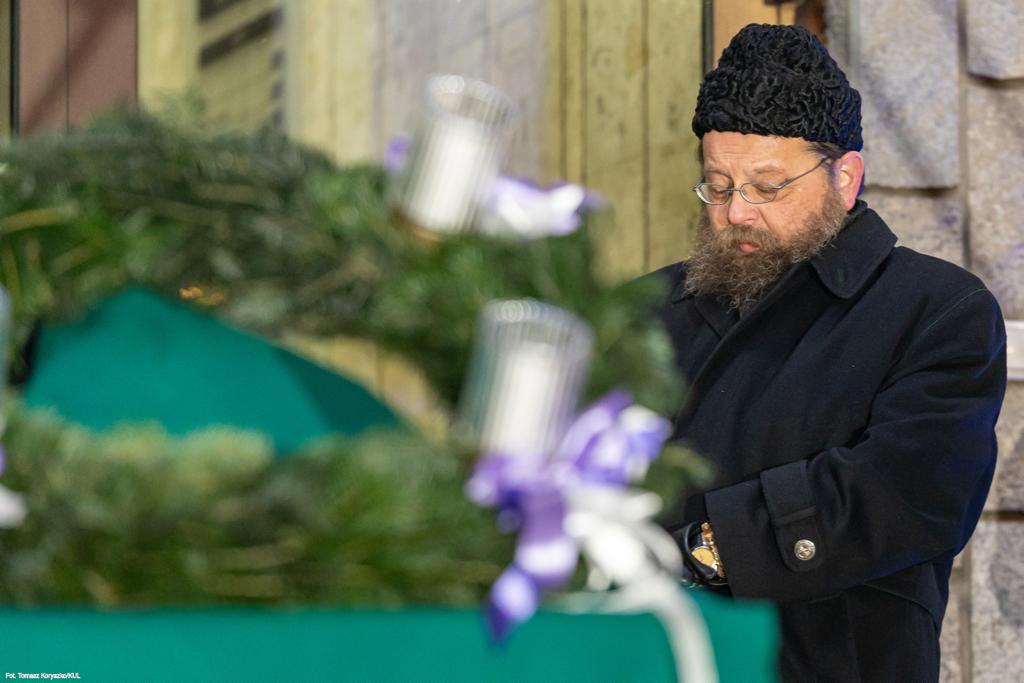
PhotoCredit: KUL_Advent_Hanukkah
*
– Світло ханукального світильника та адвентового вінка є органічною єдністю. Вона зігріває та об’єднує, – підкреслив єпископ-помічник Люблінської архиєпархії Мечислав Цісло.
Акція «Вогні у темряві», організована вперше в Люблінському католицькому університеті, зібрала багато людей – представників єврейської громади, студентів та інших людей, які прийшли до Головного корпусу Люблінського католицького університету Івана Павла ІІ, щоб взяти участь у цій символічній зустрічі. – Світло торує шлях до сердець людей і об’єднує їх. Тому сьогодні ми разом – євреї та католики. Ми, католики, відкриваємо своє юдейське коріння, а євреї відкривають братерство християнської віри. Це результат ініціатив університету, таких як створення Центру католицько-юдейських відносин ім. Гешеля, – сказав єпископ Мечислав Цісло, голова Комітету діалогу з юдаїзмом Конференції Єпископату Польщі у 2006-2016 роках.
Як підкреслив о. д-р. Павел Ритель-Андріанік, заступник директора Центру Гешеля, ханукальний світильник є знаком Старого Заповіту – відновлення Єрусалимського Храму, а адвентовий вінок символізує прихід Ісуса як Месії. – Люблін – це мультикультурне університетське місто, де до Другої світової війни працювала найбільша у світі Талмудична школа “Єшивас Хахмей Люблін”. Сьогодні найбільший католицький університет у Польщі, яким є Люблінський католицький університет, нагадує про історичний характер міста – зазначив о. доктор Андріанік.
Урочистості розпочалися з пісні Shema Israel, після чого пролунали дві промови. З єврейської сторони говорив кантор Симха Келлер, а з католицької – проф. Войцех Качмарек, керівник кафедри драми і театру Люблінського католицького університету. Зустріч завершилася спільним співом неокатехуменальних та єврейських канторів. «Світло нас об’єднує, ритуали роз’єднують, але це не означає, що наші відмінності погані. Людина несе в собі світло, яке випромінює ханукія та адвентовий вінок, резюмував Симха Келлер.
Ханука — щорічне єврейське свято, яке триває вісім днів і починається 25 числа місяця кіслев (за юдейським календарем). Свято вшановує повторне освячення Єрусалимського храму в 165 році до н.е. Ханука пов’язана з ритуалом запалювання вогнів, свічок або лампадок, розміщених на спеціальному ханукальному світильнику – Ханукії.
Історія Хануки пов’язана з подіями, що відбулися в Єрусалимському храмі 25-го числа місяця кіслев 165 або 164 року до н.е., коли сирійський і палестинський цар Антіох IV з елліністичної династії Селевкідів вирішив змусити євреїв залишили свої звичаї, традиції, Мойсеєву віру та перейняти грецькі звичаї.
Центр католицько-юдейських відносин ім. Гешеля при Люблінському католицькому університеті – науково-освітній підрозділ, який має поглибити католицько-юдейські стосунки. Його покровителем є Абрагам Й. Гешель, єврейський теолог, філософ і поет. У жовтні цього року відбулося урочисте відкриття центру. Його директором є о. проф. Мирослав Врубель.
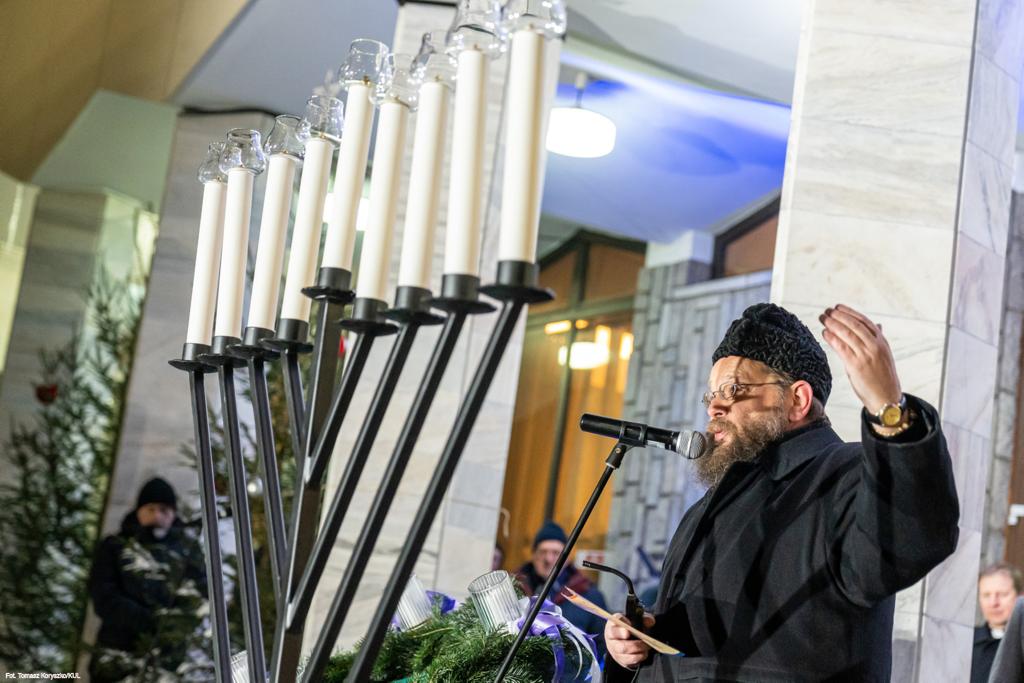
PhotoCredit: KUL_Advent_Hanukkah



Dodaj komentarz